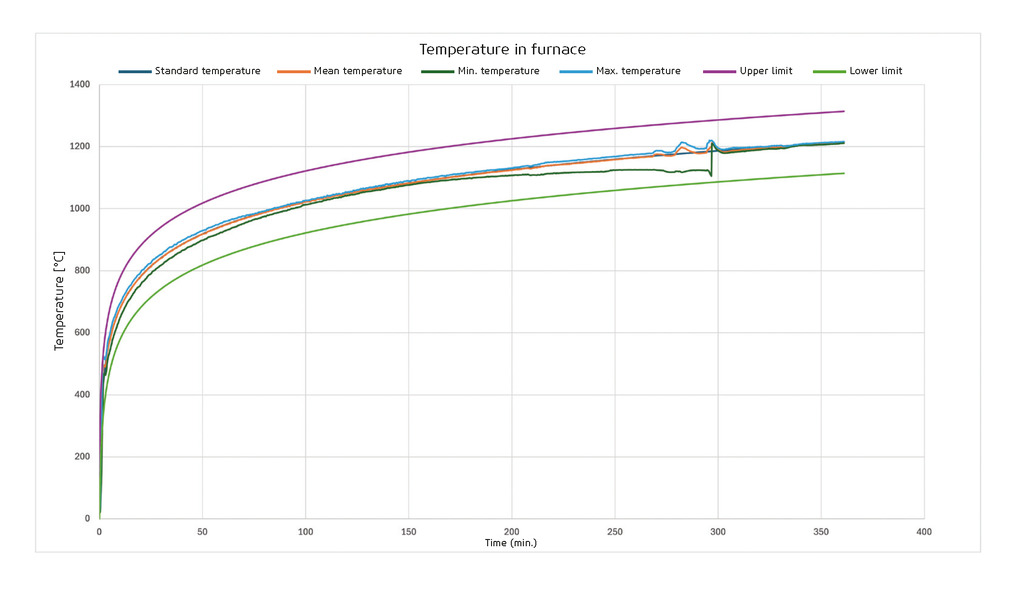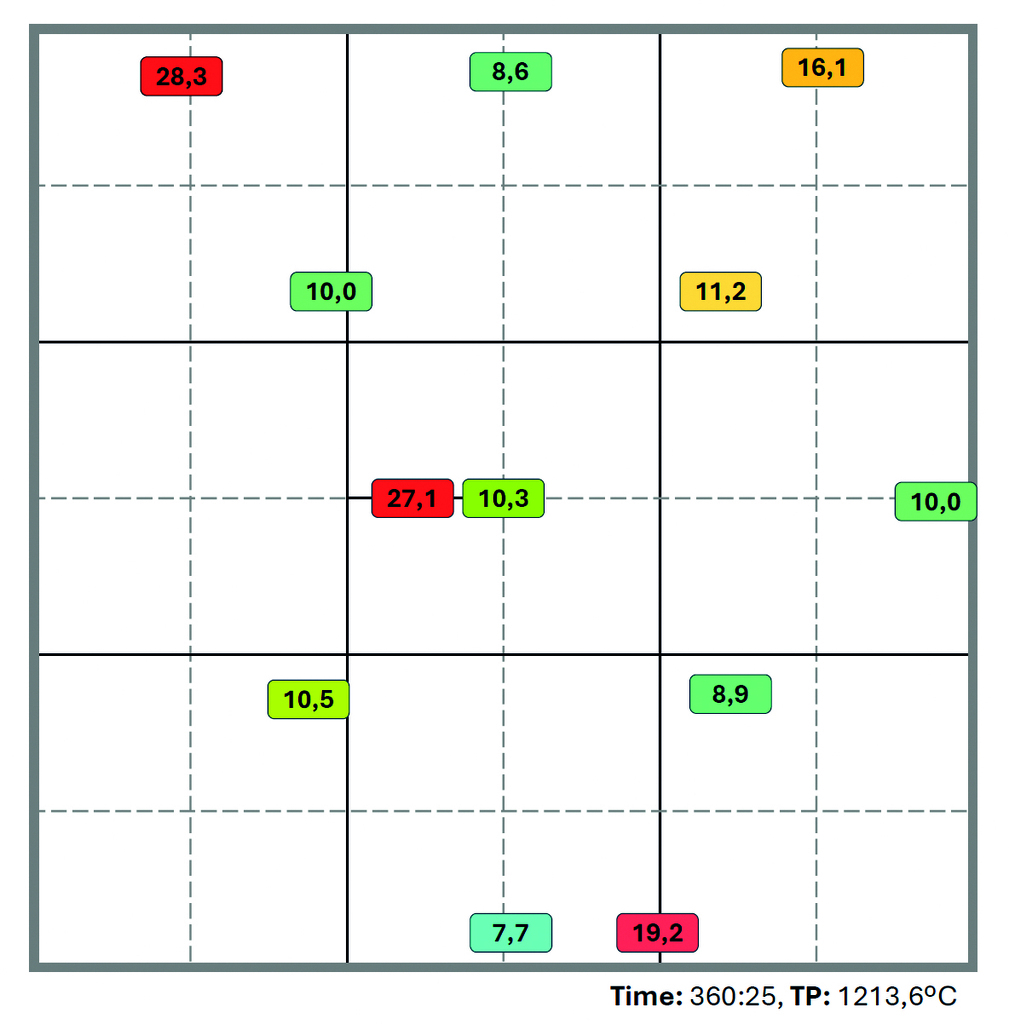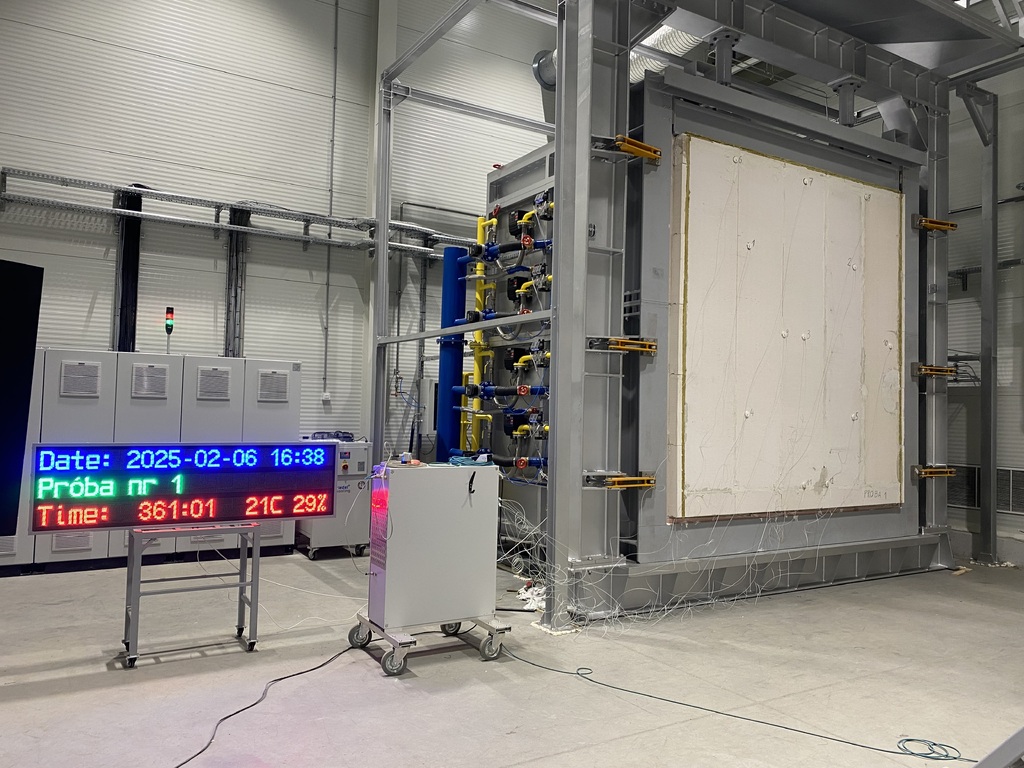Science & Innovation
Product Development Aimed at Increasing Construction Efficiency
Exceptional Fire Resistance Properties of AAC Partitions
Loading...
Wojciech Rogala is graduate of the Faculty of Civil Engineering at Warsaw University of Technology. Works as a Head of Product Development at Xella Polska sp. z o.o. and lecturer and research staff member at the Department of Production Engineering and Construction Management (Warsaw University of Technology). Active member and technical expert of Polish AAC and CSU associations – Concrete Producers Association (SPB) and Calcium Silicate Producers “Białe murowanie” Association.

Magda Kosmal is a PhD in engineering sciences and the Director of the Fire Safety and Acoustics Center at Łukasiewicz – Institute of Ceramics and Building Materials. She holds degrees in chemistry and chemical technology and completed postgraduate studies in research project management. She is the author of numerous scientific publications and leads innovative research projects, including studies on acoustic insulation of building materials and fire safety.

Robert Turski: President of the Management Board of Xella Polska sp. z o.o. and CEO of the NEE region (Northeast Europe), President of the European Autoclaved Aerated Concrete Association (EAACA), President of Association of Calcium Silicate Producers Association “Białe Murowanie”. Responsible for managing the company, driving business development, and increasing sales both in the Polish market and across the entire Northeast European region. He also leads the initiation and implementation of new digital solutions within the Xella Group. A long-time employee of the Xella Group, he brings extensive experience in innovative project development.
In early 2025, the Łukasiewicz Research Network – Institute of Ceramics and Building Materials launched a new fire resistance testing chamber. The chamber was designed for tests lasting up to 6 hours. As part of the commissioning process, a six-hour operational test was required, in accordance with the standards PN-EN 1363 [5][6] and PN-EN 1365 [7] series. A test sample had to be selected that would maintain the fire resistance criteria of load-bearing capacity (R), integrity (E), and insulation (I) for 360 minutes of fire exposure.
The selected sample was the Ytong Panel SWE P2/300 36.5 cm – reinforced AAC panels with a density class of 300 kg/m³ (300 ± 25 kg/m³) and a compressive strength of 2.2 MPa. After six hours of testing, the sample showed no significant damage, which led to the decision to conduct two additional tests – REI 60 [7] using the hydrocarbon curve and REI 60 [7] using the slow heating curve. In total, the sample endured 8 hours of fire exposure, once again proving the unique fire resistance properties of AAC.
Materials and Methods
The fire resistance of walls made from AAC masonry units is typically declared based on Tables N.B.4.1 and N.B.4.2 from standard [3]. These tables were developed during the preparation of the standard and are based on fire test data collected in EU member states. At the time of their development, AAC products with densities ranging from 350 to 700 kg/m³ were commonly used and formed the basis for the tabulated values.
Increasing thermal requirements for building partitions led to the development of AAC with lower densities. As a result, manufacturers continued to offer monolithic solutions (without additional insulation), but with reduced density (approximately 300 kg/m³). Although such densities are included in the harmonized technical specification EN 771-4 [8], they were not covered by standard [3]. For this reason, in 2019, a fire resistance test was conducted on a wall made of masonry units with the lowest density then produced in Poland (275 ± 25 kg/m³) [9]. The REI 240 test on a 17.5 cm thick wall with a density of 275 ± 25 kg/m³, without any finishing layers, was successful. This result became the basis for extension the density range in the proposed revision of standard [3].
Table 1: Fire resistance of non-loadbearing walls made of AAC, based on PN-EN 1996-1-2 standard [3]
| Minimum wall thickness (mm) for EI fire resistance1) | ||||||
EI 30 | EI 45 | EI 60 | EI 90 | EI 120 | EI 180 | EI 240 | |
350 ≤ ρ ≤ 500 kg/m3 | 50/70 (50) | 60/65 (60/65) | 60/75 (60/75) | 60/100 (60/70) | 70/100 (70/90) | 90/150 (90/115) | 100/190 (100/190) |
500 ≤ ρ ≤ 1,000 kg/m3 | 50/70 (50) | 60 (50/60) | 60 (50/60) | 60/100 (50/60) | 60/100 (60/90) | 90/150 (90/100) | 100/190 (100/190) |
Table 2: Fire resistance of loadbearing walls made of AAC, based on PN-EN 1996-1-2 standard [3]
| Minimum wall thickness (mm) for REI fire resistance1) | ||||||
REI 30 | REI 45 | REI 60 | REI 90 | REI 120 | REI 180 | REI 240 | |
α ≤ 1,0 | 90/115 (90/115) | 90/115 (90/115) | 90/140 (90/115) | 90/200 (90/200) | 90/225 (90/225) | 140/300 (140/240) | 150/300 (150/300) |
α ≤ 0,6 | 90/115 (90/115) | 90/115 (90/115) | 90/115 (90/115) | 100/150 (90/115) | 90/175 (90/150) | 140/200 (140/200) | 150/200 (150/200) |
α ≤ 1,0 | 90/100 (90/100) | 90/100 (90/100) | 90/150 (90/100) | 90/170 (90/150) | 90/200 (90/170) | 125/240 (100/200) | 150/300 (100/240) |
α ≤ 0,6 | 90/100 (90/100) | 90/100 (90/100) | 90/100 (90/100) | 90/150 (90/100) | 90/170 (90/125) | 125/240 (125/140) | 150/240 (150/200) |
1) Values in brackets represents walls with plaster
The fire resistance of walls constructed from reinforced AAC is declared based on Tables C.2 and C.3a of the EN 12602 standard [4]. Similar to walls made from masonry AAC units, scope of application tabulated fire resistance according to EN 12602 does not include AAC products with a density below 350 kg/m³. However, results presented in study [9] demonstrated that AAC with lower densities exhibits fire performance parameters that are not inferior to those defined by the standard. EN 12602 [4] also permits the declaration of higher fire resistance for reinforced products compared to those applicable to masonry units – for example, EI 360 for a wall thickness of 15 cm. Before the test, no REI 360 fire resistance tests have been conducted for reinforced AAC walls, nor for reinforced AAC walls with a density ≤ 350 kg/m³.
Table 3: Fire resistance of non-loadbearing walls made of reinforced AAC based on EN 12602 [4]
Fire resistance | Minimum wall thickness |
EI 30 EI 60 EI 90 EI 120 EI 180 EI 240 EI 360 | 50 50 75 75 100 150 150 |
Table 4: Fire resistance of loadbearing walls made of reinforced AAC based on EN 12602 [4]
Fire resistance | Min. wall thickness (non-structural reinforced AAC elements) [mm] | Min. wall thickness (non-structural reinforced AAC elements) [mm]/a |
REI 30 REI 60 REI 90 REI 120 REI 180 REI 240 | 100 100 100 100 150 200 | 100/10 100/15 125/20 150/25 175/30 200/35 |
For the operational test of the furnace, a sample composed of reinforced AAC elements was selected – specifically, the Ytong Panel P2.2/300 with a thickness of 36.5 cm. These elements contain only non-structural reinforcement, consisting of 12 steel bars with a diameter of 6 mm.
The test was conducted in accordance with the methodology outlined in standards PN-EN 1363-1:2020-07 [11] and PN-EN 1365-1:2013-04 [13]. The dimensions of the furnace chamber were: 3000 mm (width) × 3000 mm (height) × 2000 mm (depth). The duration of the test was 361 minutes. The upper edge of the tested element was subjected to a load of 110.1 kN, corresponding to 60% of its load-bearing capacity (a = 0.6).
Throughout the test, none of the fire resistance criteria were exceeded. The wall maintained its structural integrity (criterion R), no breaches or openings were observed (criterion E), and thermal insulation performance was preserved (criterion I)—with no temperature rise exceeding 180K at any measurement point. At minute 361, the furnace temperature exceeded 1200 ºC, while the temperature increased on the unexposed side ranged from only 7.3K to 10.7K at standard measurement points. A higher temperature rise (maximum 28.1K) was recorded at the location where repair plates had been installed due to transport damage. No excessive deflection was observed during the test; the maximum allowable deflection of 100 mm was not exceeded. The highest recorded deflection was 1.1 mm, measured at minute 340.
Following the REI 360 fire resistance test, the sample exhibited no signs of fire impact on the unexposed side.
The results of the initial fire resistance test were sufficiently satisfactory to justify conducting two additional tests on the same specimen, without prior removal from the furnace chamber. The second test, performed on the same sample, was an REI 60 classification test conducted using the hydrocarbon temperature-time curve [6]. This type of test is relevant for applications in the petrochemical industry and infrastructure such as tunnel tankers. It is characterized by a rapid temperature increase (ΔT ≈ 1000K within 5 minutes), simulating conditions such as a fuel tank explosion. This represents an extreme thermal load scenario, where the rapid temperature rise induces accelerated thermal expansion of the material. During the test, the wall retained all required fire resistance criteria (REI 60).
Consequently, a third test was conducted on the same specimen, this time using the slow heating curve [6]. This temperature profile is typical of fires developing gradually, such as in large ventilated spaces. In this case, the primary objective was to evaluate the performance of the furnace chamber itself, as the previous test conditions were significantly more severe.
Following the final test, no signs of thermal degradation were observed on the unexposed surface of the specimen. No further tests were conducted due to the low probability of real-world fire exposure exceeding 480 minutes. In total, the wall was subjected to over 480 minutes of fire loading, thereby demonstrating the exceptional fire safety properties of AAC.



Conclusions and Summary
In recent years, many building material manufacturers have invested significantly in product development aimed at increasing construction efficiency. This trend is largely driven by the declining interest among younger generations in manual construction work and the resulting sharp rise in labor costs. One such innovation is the use of large-format reinforced AAC panels with a density of 300 kg/m³. These elements enable fast and low-effort installation, while also shortening construction time by eliminating the need for additional thermal insulation of the partition. AAC is well known for its high fire resistance, although current standards do not cover products with this low-density class. Therefore, as part of the commissioning process for a newly constructed fire resistance testing chamber, a REI 360 test was conducted on Ytong Panel SWE P2.2/300 with a thickness of 36.5 cm, using the standard fire curve. To further evaluate the chamber’s performance, two additional tests were performed on the same specimen: REI 60 using the hydrocarbon curve and REI 60 using the slow heating curve.
After a total exposure time of 480 minutes, the wall showed no signs of fire impact on the unexposed side and retained all fire resistance criteria. Moreover, the temperature rise on the unexposed surface after six hours of testing ranged from only 7.3K to a maximum of 28.1K at the location of a repaired panel, despite furnace temperatures exceeding 1200 ºC. This minimal temperature increase is partially attributed to the use of low-density AAC, which has a low thermal conductivity coefficient of λ = 0.072 W/(m·K).
The test confirms the unique fire protection properties of AAC, even at low densities. Single-layer solutions made from lightweight AAC typically require greater thicknesses (minimum 36.5 cm), resulting in fire resistance levels that far exceed standard requirements in EU member states and typical firefighting response times.
Currently, fire resistance is not often the decisive factor in selecting wall systems, and REI 360 tests are available for only a limited number of solutions. However, in the coming years, the development of applications requiring high fire safety – such as energy storage facilities and infrastructure supporting AI development – may significantly increase the importance of meeting elevated fire protection standards.
In such contexts, modular panels made from reinforced AAC may offer a cost-effective and highly efficient construction material with expanded applicability.
References
[1] Turski, R., Rogala, W. (2022). Current situation and further development of AAC in Europe. Cement Wapno Beton, 27, Article 3. https://doi.org/10.32047/cwb.2022.27.3.1
[2] Rogala, W., Turski, R. (2024). Prospects for the development of modular panels made of autoclaved aerated concrete in Poland. Materiały Budowlane, 625, Article 9. https://doi.org/10.15199/33.2024.09.14
[3] PN-EN 1996-1-2:2010, Eurocode 6 – Design of masonry structures – Part 1-2: General rules – Structural fire design.
[4] PN-EN 12602:2016-11, Prefabricated reinforced components made of autoclaved aerated concrete.
[5] PN-EN 1363-1:2020-07, Fire resistance tests – Part 1: General requirements
[6] PN-EN 1363-2:1999, Fire resistance tests – Part 2: Alternative and additional procedures
[7] PN-EN 1365-1:2013-04, Fire resistance tests for loadbearing elements – Part 1: Walls
[8] EN 771-4:2011+A1:2015, Specification for masonry units – Part 4: Autoclaved aerated concrete masonry units
[9] Fire resistance test report no. LP02-03032/18/Z00NP